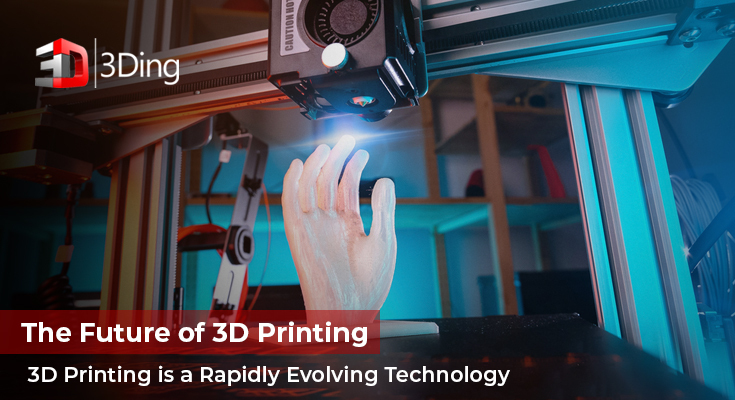3D printing is no longer just a futuristic concept seen in science fiction movies or prototyping labs. Today, 3D printing (also known as additive manufacturing) is rapidly transforming how we design, produce, and customise parts across industries from education to aerospace. At the same time, in India, the technology is gaining strong momentum, with businesses and institutions realising how having access to quality 3D printers can unlock innovation and efficiency. 3Ding brings you a curated range of top‑brand 3D printers and delivers them across the country, enabling you to step into this manufacturing revolution with confidence.
What is 3D Printing?
In its simplest form, 3D printing is the process of building a three‑dimensional object by depositing material layer by layer from a digital model. Unlike subtractive methods (cutting, milling) or traditional moulding/casting, additive manufacturing builds up the object, enabling complex geometries, custom designs, and often shorter time‑to‑market.
From a technical standpoint, several methods exist:
-
Stereolithography (SLA) – using a UV laser to cure liquid resin layer by layer. [xometry.com]
-
Fused Deposition Modelling (FDM) – melting filament and extruding layer by layer (common for prototyping and desktop printers).
-
Selective Laser Sintering (SLS) / Direct Metal Laser Sintering – lasers sintering powder materials (plastics or metals) for higher‑end industrial parts. [Encyclopedia Britannica]
Because of this additive approach, you get benefits like less waste, faster iteration, customisation, and often lower cost for small batches.
A Brief History of 3D Printing
Understanding the evolution of 3D printing gives important context for how accessible and powerful it is today.
-
The roots go back to the early 1980s. For example, in 1983, Chuck Hull developed and patented the SLA process, which marked the beginning of modern commercial additive manufacturing.[ xometry.com]
-
Over the 1990s and 2000s, additional technologies emerged (FDM, SLS, PolyJet, etc) and patents expired, which opened the door to affordable and consumer‑level printers. [3DSourced]
-
Today, the industry spans from hobby‑level desktop machines to industrial‑grade systems printing metal, composite, or multi‑material parts. The maturity of hardware, materials, and software has made 3D printing viable not just for prototyping but also for end‑use production.
This evolution means that when you partner with companies like 3Ding, you’re not just buying a machine, you’re tapping into decades of innovation, ecosystem maturity, and application experience.
Why 3D Printing Matters & Its Potential
Here are several key reasons why 3D printing is gaining rapid traction and how it can benefit organisations and individuals:
1. Rapid Prototyping & Iteration
Traditional manufacturing often involves long lead times, tooling costs, and fixed designs. With 3D printing, you can design a part, print it, test it, and revise it all within days or even hours. This agility accelerates product development and innovation.
2. Customisation & Complexity in 3D Printing
Because additive manufacturing builds layer by layer, complex shapes that are difficult or impossible with moulding or machining become feasible. Custom parts (e.g., medical implants, customised tooling, bespoke consumer goods) are increasingly practical.
3. Cost Efficiency for Small‑Batch Production
For low volumes or highly customised parts, 3D printing may reduce waste, tooling costs, and enable local production. In markets like India, where flexibility and cost control matter, this is a powerful advantage.
Broader Industry Applications
3D printing is enabling new possibilities across many sectors:
-
Automotive & aerospace: lightweight parts, complex assemblies, spares on demand.
-
Healthcare / medical devices: customised implants, dental aligners, surgical guides. In India, for example, the healthcare sector is leveraging additive manufacturing for custom medical devices. Ken Research
-
Education & research: Engineering labs, design studios, and research institutions use 3D printing to teach, innovate, and prototype.
-
Architecture & construction: Scale‑printing of models, and even experiments in 3D‑printed homes. (global overview)
-
Consumer goods & electronics: Custom‑fit products, limited edition production, and rapid design‑to‑market.
Market Growth & Especially in India
India is emerging as a fast‑growing market for 3D printing. Consider:
-
The Indian 3D printing market was valued at USD 61.4 million in 2023 and is projected to reach USD 314 million by 2030, with a CAGR of ~26.3%. Grand View Research
-
Another report indicates the Indian 3D printer market was valued at USD 15.13 billion in 2025 and expected to reach USD 38.94 billion by 2031, with a CAGR of ~17.06%. TechSci Research
-
Government initiatives and rising adoption across aerospace, defence, and healthcare are driving uptake. Ken Research
These numbers show strong headwinds and opportunities — meaning for businesses, educational institutions, and innovators in India, adopting 3D printing now can set you ahead.
How 3Ding Helps You Leverage 3D Printing Across India
3Ding plays a critical role in bridging the gap between innovative technology and organisations across India. Here’s how we add value:
1. Curated Top‑Brand Selection
We partner with globally recognised 3D printer brands like Bambu Lab, Creality, Anycubic, Elegoo, etc, that span desktop, professional, and industrial‑grade 3D Printing machines. This ensures you get reliable hardware, service, and support.
2. Nationwide Delivery & Support
From metropolitan hubs (Delhi, Mumbai, Bengaluru, Chennai) to more remote centres, 3Ding delivers across India and offers logistics, installation support, and training for your team that enabling you to adopt 3D printing without friction.
3. Application Expertise
We understand the variety of use cases, from prototyping in universities to production in manufacturing units. We guide you toward the right machine, material compatibility, further consumption (filaments, resins, powders), and workflows that deliver results.
4. Cost‑Effective Choices
With our models, you can access these technologies without paying exorbitant direct OEM premiums; we help you find the right machine‑to‑budget fit, and scale as your needs grow.
5. Future‑Ready for Growth
As your adoption matures, maybe moving from simple plastic prints to metal parts, multi‑material prints, or 3D‑printed tooling — 3Ding supports you with upgrades, material suggestions, and service contracts.
By choosing 3Ding, you are not just buying a machine, you’re investing in a partner who understands how 3D printing translates into real‑world gains in India.
Key Considerations Before Buying a 3D Printer
If you’re exploring 3D printing and evaluating options (with 3Ding or otherwise), here are important factors to keep in mind:
1. Use‑Case & Material Requirements
Ask: What will you print? Prototypes, end‑use parts, dental implants, spare parts? Different use‑cases require different print technologies (FDM vs SLA vs SLS), materials (PLA, ABS, nylon, metals), and post‑processing. The hardware choice should align with your workflow.
2. Build Volume & Precision
How big are the objects? Do you need fine resolution or large scale? These affect cost, machine size, and required infrastructure (ventilation, power).
3. Material Cost & Availability
Materials (filaments, resins, powders) have varying costs, and availability in India matters. Also, the cost of maintenance and consumables should be factored in.
4. Software & Workflow
Ensure the printer is compatible with your CAD/design workflow and that you have the right slicing software, support for upgrades, and community or vendor assistance.
5. Support & After‑Sales
Technical support, installation, spare parts, and training are crucial, especially in India, where machine downtime can impact productivity.
6. Total Cost of Ownership & ROI
Beyond the purchase price, consider ongoing consumables, maintenance, post‑processing, space/energy. Map your return‑on‑investment: faster prototyping? Reduced outsourcing? Custom manufacturing? These gains justify the spend.
Real‑World Applications in India
To illustrate the impact of 3D printing in India and how adopting the right technology can drive benefits, here are some examples:
-
According to a report, in India between 2022‑24, over 220 SMEs in Chennai’s Sriperumbudur industrial zone adopted in‑house 3D printing for product development, reducing prototyping cycle time by ~55% and prototype outsourcing cost by ~48%. [print3.in]
-
In the medical/dental space: 45 dental clinics in Delhi‑NCR used 3D printing technologies from 2023‑25 to produce over 18,500 custom devices locally, cutting turnaround time from up to 4 weeks to under 6 days and reducing cost by ~40%. [print3.in]
-
For Indian industries, major sectors benefiting include automotive (spares, prototyping), aerospace (lighter components), healthcare (implants, prosthetics), electronics (rapid design), and architecture (complex models).[ 3ding.in]
These examples show that with the right printer (and support), the benefits are tangible — faster time‑to‑market, cost savings, local production, and the capability to customise.
Why Now is the Right Time for India
Several factors make this the opportune moment for adopting 3D printing in India:
-
Rapid market growth and increasing adoption across sectors indicate strong momentum and maturity.
-
Government initiatives and investments (for example, in additive manufacturing centres) are creating an enabling ecosystem. [Ken Research]
-
The cost of hardware and materials is reducing, and the variety of available printers (desktop to industrial) is broader, meaning organisations of many sizes can access the technology.
-
Early adopters in India are gaining the benefits of speed, customisation, and local manufacturing before more widespread uptake occurs.
-
With 3Ding’s nationwide delivery & Technical support, organisations across India, not just in major metros, can now access world‑class 3D printing hardware.
How to Choose the Right 3D Printer with 3Ding
When you connect with 3Ding and explore your options, here’s a simplified process we recommend:
-
Define your objective: What kind of parts will you produce? What is your volume, material, and finish expectation?
-
Budget & scale: Are you starting with a small setup or looking at a larger production scale?
-
Select technology: Based on material/finish, choose whether FDM, SLA, SLS, or other technology.
-
Evaluate brands/models: We carry top‑brand machines — compare specs, build volume, resolution, material compatibility, software ecosystem.
-
Consider operational needs: Power, ventilation, workspace, post‑processing tools, and consumables.
-
Plan for training & support: We at 3Ding assist with installation, initial training, maintenance plan, and material sourcing.
-
Calculate ROI & timeline: Estimate cost savings (outsourced prototyping, spares, custom parts) and time savings (faster iterations) to justify investment.
-
Scale for the future: Choose a machine that allows you to grow — upgrade capability, modularity, material flexibility.
Conclusion
The world of manufacturing is changing. 3D printing has moved from niche prototyping to mainstream production, customisation, and innovation. In India, the growth trajectory is strong, and the time is ripe for organisations, institutions, and enterprises to adopt this technology and gain a competitive edge.
With 3Ding as your partner that delivers top‑brand 3D printers across India, backed by support, service, and local expertise, you’re well‑positioned to ride this wave. Whether you’re looking to prototype faster, manufacture custom parts, reduce costs, or explore new design frontiers, 3D printing opens the door.
If you’re ready to explore the possibilities, browse our range of 3D printers in India, talk to our team about your use case, and let 3Ding empower your innovation. Transform your ideas into reality layer by layer.
Visit 3Ding’s website or contact us today to find the right 3D printer solution for your needs. Empower your team with world‑class additive manufacturing technology and stay ahead of the curve in India’s growing 3D printing ecosystem.




